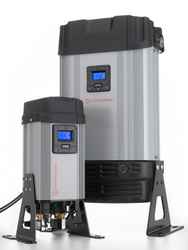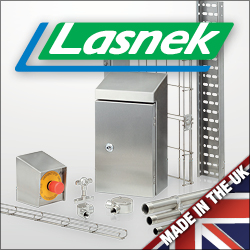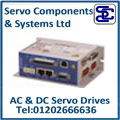
Posted to News on 5th Nov 2014, 14:02
Removing contaminants from compressed air
Unlike other utilities, the quality and cost of compressed air are the user's responsibility, meaning the user must understand potential issues affecting air quality, the major one being contaminants.

In a typical system, contaminants come from four sources - atmospheric air, the compressor, the receiver and distribution pipework - and include water vapour, water aerosols, dirt particles, micro-organisms, hydrocarbons, oil vapour, liquid oil and aerosols, condensed liquid water, rust and pipescale.
Oil and particulates can be removed by filtration. Water vapour, however, passes easily through water separators and coalescing filters so must be removed by a dryer.
A dryer's water vapour removal capability is expressed as Pressure Dewpoint (PDP). Dewpoint refers to the temperature at which condensation occurs, while PDP refers to the dewpoint of air above atmospheric pressure. High-efficiency dryers are used where humidity levels, or PDPs, are specified to ISO 8573.1:2010 which specifies compressed air purity with respect to particles, water and oil.
In critical applications, refrigeration dryers are unsuitable since they cannot produce a dewpoint below freezing. Here, a PDP of -40degC is recommended because a PDP lower than -26degC will stop corrosion and inhibit micro-organism growth. Refrigeration systems also usually use ozone-depleting CFC gases and can be expensive and bulky, while requiring specialist maintenance.
Membrane dryers are usually limited to low-capacity applications and their purge air requirements are usually higher than desiccant dryers. Membrane life can be limited and a high level of inlet filtration is needed. They are also prone to chemical attack and can suffer catastrophic failure from shock and vibration.
With dewpoints of -20degC, -40degC or -70degC, adsorption dryers usually employ heatless pressure swing adsorption (PSA), also known as heatless regeneration.
Through adsorption, specific molecules (the adsorbate) adhere to the surface of a highly porous solid (the adsorbent) by electrostatic and molecular forces. The adsorbent has a pore structure comprising larger or macro pores, slightly smaller or mesopores, or very small micro-pores. The adsorbent is normally made into granules or beads with a clay binder to form packed beds through which the adsorbate is passed.
Regenerating desiccant material
To continuously supply dry air, an adsorption dryer must regenerate the desiccant material. The simplest method is to pass clean, dry air - purge air - over the wet adsorbent material. To enable this, PSAs have two vessels - while one is drying, the other is undergoing regeneration. There are two types of PSA design: twin tower and modular.
Installation of twin tower PSAs may require extensive pipework, plant modification and inlet and outlet filtration. They also require a large volume of desiccant. The fill method used on twin tower designs can lead to inconsistencies in drying, desiccant regeneration and dewpoint while desiccant attrition can reduce adsorption capacity and lead to blocked outlet filters. Being based on pressure vessels, they are also subject to the Pressure Equipment Directive for annual inspection and certification. Traditional desiccant dryers can also suffer from purge air losses up to 25 per cent.
Modular PSAs use a replaceable desiccant cartridge, rather than pressure vessels, in a heatless twin-chamber configuration within a housing. Wet air from the after-cooler enters the dryer and is directed into one chamber. Water and particulates are removed by the filtration stage with water retained within the dryer until the column is regenerated, when it will be vented to atmosphere as it is depressurised. Following filtration, air passes through the desiccant bed where any remaining moisture is adsorbed. Finally the dry air passes through a particle filter, which retains any remaining desiccant particles. Meanwhile, a small amount of dry air is counter-flowed down through the second chamber and exhausted to atmosphere, removing moisture and regenerating the desiccant. Electronic controls periodically reverse each column's function to ensure a continuous dry air supply.
Attrition - efficiency loss resulting from clay/ crystal structure breakdown within the dryer - can significantly affect performance.
Of key importance is the cartridge filling method. "Tip and pour' methods result in loose fill and can hinder efficient channelling of air, preventing some of the desiccant being used for drying while allowing the desiccant beads a higher degree of movement relative to each other.
Snowstorm filling
One means of countering this is snowstorm filling via a specialist device optimised for the cartridge and bead diameter. This maximises packing density - restricting bead movement - and minimises desiccant bed fluidisation, allowing all the available desiccant to be used for drying.
Failure to ensure even flow across drying surfaces will cause greater friction in some areas of the bed, accelerating degeneration. Excessively high flow can also create shock loading or overloading. This can create voids in the dryer bed structure while the resulting dewpoint loss will impact both drying efficiency and the application. A further issue is dust build-up as the drying bed breaks down, again impacting efficiency and potentially blocking filters and silencers.
Excessive flow velocity can be addressed by repressurising the drying bed to negate the possibility of a high pressure differential between the two ends of the bed on column change-over, while a flow limiter or sonic nozzle will help control air flow and ensure the outlet dewpoint is unaffected. Meanwhile, excess dust can be prevented by adding an extra air filtration stage after one column is regenerated before regeneration of the other column commences.
Desiccant air dryer designs vary significantly and it is important to ensure correct sizing based on outlet flow. Silencer maintenance is critical, since increasing back pressure as they block with desiccant dust will reducie volumetric flow of the purge air, leading to incomplete regeneration, sub-optimal performance and possible failure. Modern dryers using the replaceable desiccant cartridge system typically now contain additional flow management and filtration safeguards to prevent accidental misuse and deliver consistent, reliable operation.
For further information about contaminant removal from compressed air visit www.norgren.com/dryers/global.


















